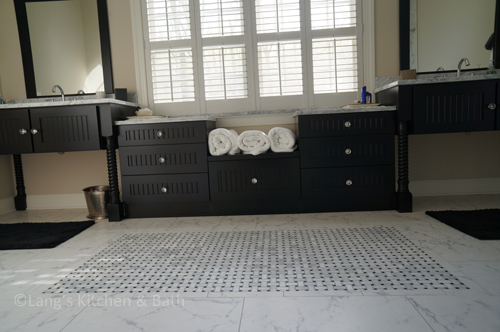Are Heated Floors Really Worth It?
/As Fall settles in and the weather gets cooler, our focus shifts from t-shirts and sandals to sweaters and boots. In the home, running the air conditioner turns into nonstop heating. Who doesn’t love a cozy, warm home when the outside temperatures start to drop?
One way to ensure you are toasty warm at home is to include underfloor heating in a kitchen remodel or bathroom renovation. Imagine being able to walk into your master bath or across your kitchen first thing in the morning barefoot, with the feeling of a heated floor underneath? It is pure bliss! Installing underfloor heating is not a small task, but a remodeling project is the perfect time to consider adding this to your home heating system. It is also a much sought-after feature in kitchen and bath design, and could add to the resale value of your home.
Here are 5 things you need to know about radiant underfloor heating, to help you decide if it is a worthwhile investment for your next kitchen and bath design.
What is radiant underfloor heating?
Radiant underfloor heating is an in-floor heating system that can be used in the entire home or only in selected rooms. It can be a supplement to another heating system or serve to heat an entire area of your home.
Why include underfloor heating?
A heated floor is not only a luxury, it is also an effective way to heat your room and keep you cozy. In a normal heating system, hot air rises and therefore moves away from where you are located. With underfloor heating, the warmth is concentrated at your feet and only moves up into the room slowly. It also keeps your feet nice and toasty, which makes the rest of your body feel warmer, so you may require less heat throughout the house.
Why would you not include underfloor heating?
To install a heating system under the floor, you must first remove the floor. If you are embarking on a home remodeling project and plan to replace floors, this is the perfect time to consider including underfloor heating. If you are not, then the expense of ripping up floors just to install underfloor heating may be prohibitive. Also, carpet is not the best conductor for underfloor heating. If you are addicted to thick carpeting throughout the house, this may not be the best solution for heating your home.
What type of underfloor heating should you install?
Radiant underfloor heating is installed underneath your floor and is available in several different systems. The two that are most often used in homes are hydronic and electrical. Hydronic systems use hot water tubes. They have a higher initial installation cost with a lower ongoing operational cost, making them more cost effective for larger spaces such as a kitchen design or living area. Electrical systems use electric wires and are less expensive to install but cost more to run, so may be a better solution for smaller areas such as a bathroom design.
What materials work best with it?
Underfloor heating works best with materials such as stone, ceramic, and polished concrete that conduct heat more effectively while not being subject to damage from the heat. Most carpets insulate floors and do not allow you to experience the full benefits of underfloor heating. Wood flooring can work well with underfloor heating, but take care in choosing a wood type and installation method that results in the best heat conduction and can handle moisture produced by the heat.
Assess the options and examine the pros and cons with your home remodeling expert. Underfloor heating is an ideal solution for spaces like a bathroom remodel, since it is a smaller area and typically includes tile floors that are an ideal conductor for this type of heating. Kitchen designs with tile or wood floors, mudrooms, and entry ways are other locations you may consider for adding underfloor heating.
Contact us today to discuss your home remodeling requirements and if underfloor heating is the best solution for your home!






